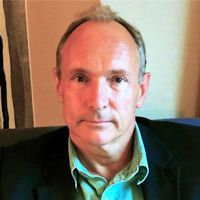In 1989, while working at CERN, TIM BERNERS-LEE proposed a global hypertext project, to be known as the World Wide Web. Based on the earlier "Enquire" work, it was designed to allow people to work together by combining their knowledge in a web of hypertext documents. He wrote the first World Wide Web server, "httpd", and the first client, "WorldWideWeb" a what-you-see-is-what-you-get hypertext browser/editor which ran in the NeXTStep environment. This work was started in October 1990, and the program "WorldWideWeb" first made available within CERN in December, and on the Internet at large in the summer of 1991.
From 1981 until 1984, Berners-Lee worked at John Poole's Image Computer Systems Ltd, with technical design responsibility. Work here included real time control firmware, graphics and communications software, and a generic macro language. In 1984, he took up a fellowship at CERN, to work on distributed real-time systems for scientific data acquisition and system control. Among other things, he worked on FASTBUS system software and designed a heterogeneous remote procedure call system.
In 1994, he founded the World Wide Web Consortium at the then Laboratory for Computer Science (LCS) which merged with the Artificial Intelligence Lab in 2003 to become the Computer Science and Artificial Intelligence Laboratory (CSAIL) at the Massachusetts Institute of Technology (MIT). Since that time he has served as the Director of the World Wide Web Consortium a Web standards organization which develops interoperable technologies (specifications, guidelines, software, and tools) to lead the Web to its full potential. The Consortium has host sites located at MIT, at ERCIM in Europe, and at Keio University in Japan as well as Offices around the world. In 1999, he became the first holder of the 3Com Founders chair.
He is currently the 3COM Founders Professor of Engineering in the School of Engineering, with a joint appointment in the Department of Electrical Engineering and Computer Science at CSAIL where he also heads the Decentralized Information Group (DIG). In December 2004 he was named a Professor in the Computer Science Department at the University of Southampton, UK. He was co-Director of the Web Science Trust, launched in 2006 as the Web Science Research Initiative, to help create the first multidisciplinary research body to examine the World Wide Web and offer the practical solutions needed to help guide its future use and design. He is a Director of the World Wide Web Foundation, started in 2008 to fund and coordinate efforts to further the potential of the Web to benefit humanity.
In June 2009 then Prime Minister Gordon Brown announced that Sir Tim Berners-Lee would work with the UK Government to help make data more open and accessible on the Web, building on the work of the Power of Information Task Force. Sir Tim is currently a member of The Public Sector Transparency Board to drive forward the UK Government’s transparency agenda. He is the author of Weaving the Web.
In 2012 he was honored by the 2012 OLYMPICS Committee by being assigned a starring role in the opening night ceremonies. Appearing alone, sitting at a NeXt computer, he typed out the following Tweet:
"This is for everyone #london2012 #oneweb #openingceremony @webfoundation @w3c"

